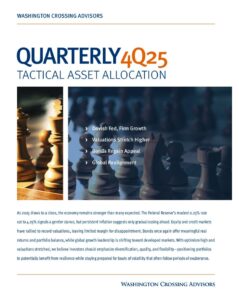Insight & Commentaries
Last week’s Chicago Purchasing Manager’s Survey Index (PMI) indicated significant weakness in manufacturing during the month of February. The index plunged from near 60 in January to 45.8 in February. The 14-point fall brought the index to below 50, a level that is generally associated with recession. Investors focus on the Chicago PMI because it is the first in a series of indicators that describe the health of the cyclical manufacturing sector. Today, we will get a look at the much broader Institute for Supply Management’s (ISM) Manufacturing Survey Index. Purchasing managers’ reports are interesting because they are on the…
After a six-month-long period of generally weakening global data, we are watching for signs that those trends are about to turn. Although our fundamental conditions barometer has yet to turn, very recent indications seem to be hinting at the possibility of a pickup in growth. Macro View Having an unbiased method for tracking changes in fundamental conditions helps keep us on our toes and responsive to changes in conditions that have the ability to impact returns. Although equity indices are near highs, a broader look at the data led us to reduce expectations through the back half of 2014 and into the first part…
Macro View A meeting between Euro-area finance ministers, central bankers, and European Commission officials ended abruptly Monday, as a Greek government official said the Euro area’s recommendation to extend bailout conditions was unacceptable. Greece’s current aid package expires February 28, thus necessitating a new round of negotiations between Greece and its creditors. The newly-elected Greek government is seeking a new deal with easier terms. The cost of Greek debt and the cost for bondholders to insure against a Greek default has risen dramatically in recent months, suggesting real concern about the potential for some form of default. Monday’s failed negotiation…
Payroll data suggests the U.S. is still the best alternative for global growth, but global conditions remain weak, and Europe and China continue to face significant challenges. Meanwhile, domestic earnings continue to grow, as first quarter S&P 500 earnings per share (EPS) growth tracks toward 6% excluding energy (3% growth if energy is included). Analysts expect 3.4% growth in S&P 500 operating earnings this year, according to the most recent survey from FactSet. Macro View Last week’s payroll number for January, along with upward revisions to prior months, was far better than expected and strengthens the bull case for the…
Thursday’s European Central Bank (ECB) announcement on monetary policy should attract considerable investor attention, given mounting deflation concern and faltering growth across much of Europe. Macro View The flow of data relating to economic and market fundamentals has become increasingly mixed as global inflation slips, demand from emerging markets weakens further, and investors express higher risk aversion. The widening of credit spreads, flattening of the yield curve, and an increase in volatility, as measured by the VIX, are all clear manifestations of heightened risk aversion. These impulses, coupled with continued signs of weakness in global growth, have led to declines…
Energy price declines should provide a benefit to global growth and lower inflation. Real growth could be materially boosted by lowered energy and gas prices by as much as $100 billion in the United States alone, as the lower price acts as a positive shock to consumption. On the flip side, we recognize that the impulse for lower prices emanated from weaker demand from emerging markets. Should the Federal Reserve (Fed) proceed with a midyear rate hike, one less prop for commodity prices will be removed. It is hard to interpret exactly how much of this is already priced in…
As we head into the new year, we see the United States economy emerging as a bright spot on the global stage. For 2015, we expect to see above-trend growth, further improvement in private sector balance sheets, and generally improved confidence. The domestic economy should perform better than Europe, where structural reform is still needed, and better than many of the emerging markets, which continue to struggle. Chinese growth should continue to moderate, while Russia and other large net energy exporters will struggle given today’s lower oil price. A recent modest pickup in volatility, slippage in Treasury yields, and a…
First Quarter Asset Allocation Review As we head into the new year, we see the United States economy emerging as a bright spot on the global stage. For 2015, we expect to see above-trend growth, further improvement in private sector balance sheets, and generally improved confidence. The domestic economy should perform better than Europe, where structural reform is still needed, and better than many of the emerging markets, which continue to struggle. Chinese growth should continue to moderate, while Russia and other large net energy exporters will struggle given today’s lower oil price. View Full Report (Adobe PDF)
Macro View As 2014 starts to wind down, we see oil prices headed south along with bond yields and equity prices closing near the highs for the year. This is a happy state of affairs for most, as 401(k) values are getting a boost while daily living expenses get a bit easier to carry. In contrast to the oil shocks that occurred in 1973-1974, 1979, 1980, 1990, and 2003-2004, today’s sharp drop in oil prices is conveying benefits to the average worker who has been struggling to see a real increase in wages. With the average price for a gallon…
Last week’s strong jobs report continues a trend of solid data that suggests the U.S. economy is closing out 2014 with good form. Macro View The U.S. economy continues to deliver relatively solid results. Just recently, we’ve seen impressive results on employment, purchasing managers indices, and vehicle sales. Notably, last month’s 321,000 jobs added were the most since January 2012. To put this in perspective, the total number of private sector jobs added in the past year is close to 2.66 million. This pace is better than our expectation for this year and is near the peak level of job…



